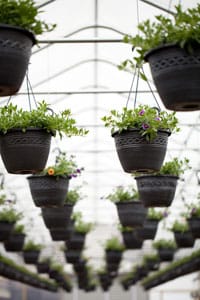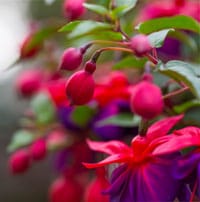Newsletter Articles
The Best Flowering Plants for Hanging Baskets
Written by Susan B.
Hanging baskets have many uses. Some of the best flowering plants for hanging baskets need to be protected from direct sunlight – particularly during the hottest months of summer. Use these plants to spruce up your front porch, or to brighten your covered patio. You can even hang them from trees to define shaded seating areas in your garden. Wherever you use them, you’ll be able to enjoy a colorful display for much of the growing season. With proper care, you might even be able to keep them blooming beyond the growing season because of our ideal Southern California climate.
First Things First
Regardless of the type of hanging planter you choose or its size, be sure that your container had drainage holes that will minimize your risk of overwatering. If you’re going to use potting soil, plan to buy Perlite, compressed coconut coir, and/or peat moss to mix with the potting soil. This will ensure that your growing medium won’t get so compacted that it can’t drain properly or let the plant roots breathe.
Easy Low-Maintenance Flowering Plants for Hanging Baskets
-
Petunias

Petunias are easy to grow, and they’re readily available. You may even be able to purchase them in pre-planted hanging containers. These fast-growing colorful flowers bloom prolifically throughout the growing season. Deadhead spent flowers after they fade. Doing so will keep your plant looking neat and encourage it to continue flowering. Put your petunia basket in a location where it gets full sun. Water your plants regularly, and check to see if the soil is dry before you water them.
-
Portulaca or Moss Rose
This tropical native comes in a vast range of colors, and you’re likely to find mixed colors in hanging baskets or multi-plant blister packs. It is a drought-tolerant succulent that thrives in full sun and hot temperatures. The flowers bloom at the end of needle-like leaves, but the leaves aren’t sharp. Our mild Southern California climate is such that you’ll be able to grow Moss Rose as a perennial.
-
Nasturtiums
There are many varieties of Nasturtiums, but trailing cultivars are ideal for hanging baskets. You can grow them from seed or purchase starter plants. If you want to grow them from seed, we recommend that you soak the seeds for at least 24-hours before planting. Nasturtiums don’t require a lot of maintenance, and they thrive in warm and sunny locations. However, they’ll also do well in partial shade.
-
Begonias
There are many types of begonias, but for hanging baskets, we’re thinking about tuberous varieties. Pendula or hanging begonias have an atypical growth habit. Most begonias (and other flowering plants) grow up toward the sun. Pendula begonias grow towards the ground. And their downward growth is the characteristic that ideally suited to hanging baskets. The flowers of Pendula begonias look deceptively large. What you’re seeing is an illusion because these plants really produce tiny flowers that grow in cluster formations off the very short, thin stems that branch off from the main plant stems.
Place your Pendula begonia hanging basket in a spot where they’ll be protected from the hottest summer sun. They thrive in filtered light. The maximum length of Pendula begonia stems is about 15-inches.
Cascade Begonias are aptly named for how the flowers cascade over the edges of the containers they’re grown in. Their cascading growth habit makes them well-suited to growing in hanging baskets. Cascade begonias produce spectacularly colorful double flowers. Grow Cascade begonias in a spot that gets indirect light. Hang them from a pergola, or a sturdy tree branch. Be careful not to overwater them. Cascade begonias reach a height of between 12-and-16-inches.
-
Fuchsia

Fuchsia belongs to a genus of 105 species. These plants bloom from spring until fall. Some cultivars sprawl over the edges of containers and these are ideal for hanging baskets. Fuchsia is an excellent pollinator plant, so its nectar-rich flowers will attract butterflies and hummingbirds. Because fuchsia is susceptible to root rot, plants need fast-draining soil. If you use potting soil, add equal parts of Perlite, coconut coir, or peat moss. If you hang hummingbird feeders, you can use hanging baskets with fuchsia to block the view between feeders. That may be an effective way to prevent aggressive hummingbirds from chasing other hummingbirds away.
-
Lobelia
The most familiar Lobelia cultivar that we see in hanging baskets is also known as dwarf Lobelia or edging Lobelia. Either way, it’s botanical name is Lobelia erinus. It is characterized by tiny dainty flowers, the most familiar of which are deep blue or purple. This particular variety is ideally suited to growth in hanging baskets, containers, and window boxes. It is especially attractive when combined with other flowering plants in hanging baskets. One of our favorite combinations is fuchsia and lobelia. The low-growing Lobelia contrasts beautifully against the colors of the fuchsia flowers.
Come in and talk to our garden experts. They’re always eager to help customers choose flowering plants, and they’ll guide you as to what will grow best in hanging baskets for your property’s lighting conditions and your personal maintenance needs.
Do you like what you see? Sign up for our weekly newsletter to get content like this every week!

